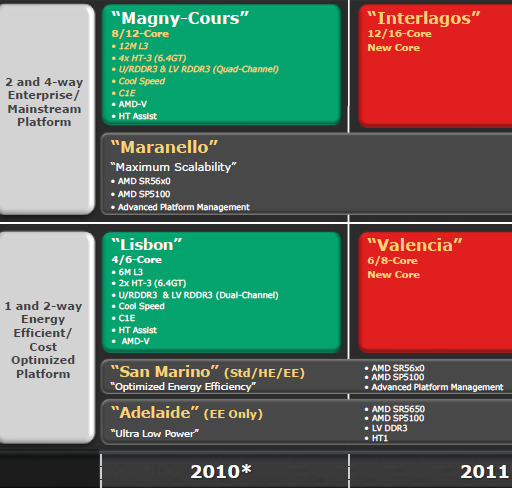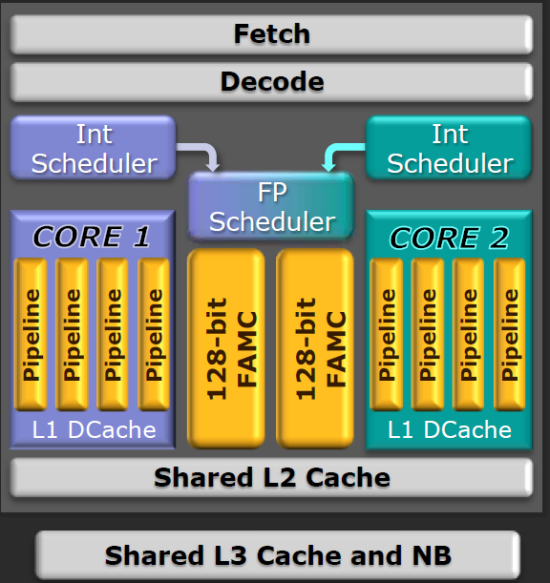AMD's 2010/2011 Roadmap from the IT Professional’s Perspective
by Johan De Gelas on November 23, 2009 12:00 AM EST- Posted in
- IT Computing
Expensive 2-Socket Servers
When it comes to expensive 2-socket servers, AMD positioning is cunning. In the midrange we will find servers with sixteen Opteron cores (2-socket x 2-quad-core die per socket) offering 8 memory channels and 24 DIMM slots. Performance will probably be “close enough” to the Westmere EP servers , which can only offer six memory channels and 18 DIMM slots. The extra amount of memory bandwidth might make a dual Opteron 6100 attractive to the HPC folks, while the higher amounts of DIMM slots together with a competitive price may very well convince the virtualization market.
Midrange and Budget 2-Socket Servers

Ultra Low Power Server
AMD had some succes in the ultra low power market and clearly wants more. The “Adelaide” platform is the successor the power optimized “Kroner” platform. Low power memory and chipset, voltage regulators and PSUs that only support low power Opterons: every component is tuned for low power. Remarkably, the ACP of the Opteron 4100 EE is lowered to a very low 35W ACP, or less than 6W per CPU. AMD feels these CPUs offer an excellent alternative to the VIA Nano and Intel Atom based servers. Instead of running one small website on an Intel Atom based server, AMD hopes that ISPs will prefer to run 6 websites on a container based solution. So each website would get it’s own 6 Watt core which is much more powerful than the best Intel Atom CPUs.
Upgrade to Bulldozer

We will discuss this core in more detail but here are some extra tidbits we managed to find out:
• Two integer clusters share fetch and decode logic but have their own dedicated Instruction and Data cache
• Integer clusters can not be shared between threads: integer cores act like a Chip Multi Processing (CMP) CPU.
• The extra integer core (schedulers, D-cache and pipelines) adds only 5% die space
• L1-caches are similar to Barcelona/Shanghai (64 KB 2-way? Not confirmed)
• Up to 4 modules share a L3-cache and Northbridge
• Two times 4 Bulldozer modules (2 x 8 "cores" or 16 cores) are about 60 to 80% faster than the twelve core Opteron 6100 CPU in SPECInt_rate.
With Bulldozer, AMD finally seems to have designed an aggressive integer core. Since the introduction of the Intel Woodcrest in 2006, Intel’s CPUs have been offering superior integer crunching performance per core. Since integer performance determines the performance of 90-95% of the server application out there, this is a big deal.
Conclusion
Intel has a very strong product lineup for each segment of the market: the massive octalcore Nehalem EX for the “mission-critical” high-end, the six-core Westmere-EP for the midrange and the “Lynfield” based Xeons for the low power market. But AMD doesn't roll over willingly: it breaks all market segment rules and shatters some (artificial?) boundaries. That will result in some very interesting opportunities for the server buyers in 2010.
So which products are worth watching or waiting for? The G34 Opteron 6100 will find a home in 48-core servers, and these servers should be a cheaper alternative to the 32-core Nehalem EX servers in the high-end. We are not completely convinced that performance and RAS features will be compelling enough to sway the typical Nehalem EX buyers (OLTP, ERP) towards an AMD Opteron server. That is our first impression, but we will give AMD the benefit of the doubt of course.
We are much more enthusiastic about AMD’s highend 2-socket platform. The fact that you will be able to buy a relatively cheap (compared to 4-socket solutions) 2-socket server with two quad channel octal cores is very attractive and a great strategic move by AMD. A platform with 16 cores (or 24 if you like) and 24 DIMM slots might attract quite a lot of typical 2-socket “virtualization consolidation” server buyers.
The other really compelling offer to the market might be the Adelaide platform, depending on how high the premium is that AMD wants for its EE Opterons. AMD has been asking pretty high prices for it’s lowest power Opterons, clearly targetting the "Facebooks" and "Googles" of the world. But if AMD is going after the Intel Atom server market, it may mean that it's going to offer some low power products in price ranges that are interesting to the rest of us.










107 Comments
View All Comments
nafhan - Tuesday, November 24, 2009 - link
The numbers imply a 20% - 35% improvement per core.12*1.6/16=1.2 and 12*1.8/16=1.35
qcmadness - Tuesday, November 24, 2009 - link
it would be nowhere enough to compete with Nehalem / Sandybridge (with >100% more integer performance in server applications)4lpha0ne - Tuesday, November 24, 2009 - link
If you are concerned about the FP performance, then have a look at this blog: http://citavia.blog.de/">http://citavia.blog.de/ (it's in English).Paladin1211 - Tuesday, November 24, 2009 - link
"The Opteron 6100 also has 50% more cores"It has 12 cores, 100% more than an Istanbul, and 200% more cores than Nehalem 5500.
Paladin1211 - Tuesday, November 24, 2009 - link
Oh, sorry, you meant the Nehalem EX, I misread the sentence :DGourdFreeMan - Tuesday, November 24, 2009 - link
Johan De Galas wrote:"It was hardly noticeable but AMD made a historic step forward in September 2009 with the introduction of it’s own server chipsets. For the first time, AMD is a real server platform supplier, in control of both the CPU and chipset."
Not true. AMD was the original supplier of chipsets for its Opteron processors. Remember the AMD 8000 series chipsets?
brshoemak - Tuesday, November 24, 2009 - link
I was thinking the same thing, so I looked:http://www.amdboard.com/opteron_chipsets_amd.html">http://www.amdboard.com/opteron_chipsets_amd.html
http://www.amd.com/us-en/Processors/ProductInforma...">http://www.amd.com/us-en/Processors/Pro...ion/0,,3...
http://www.amd.com/gb-uk/Corporate/VirtualPressRoo...">http://www.amd.com/gb-uk/Corporate/Virt...sRoom/0,...
JohanAnandtech - Tuesday, November 24, 2009 - link
I do not disagree, but understand that these chipsets were "good enough to get the platform going" efforts. IIRC, all these chipsets were not exactly the state-of-art chipsets, they lacked quite a few features. I remember the AMD760MP having no real support for USB for example. These were decent stable chipsets, but AMD just produced because they wanted VIA and NVIDIA to take over. As soon as Nvidia produced enough nForce Pro chipsets, I remember seeing very few 8000 chipset based servers.It is a whole different situation today. I agree I might have oversimplified, but still I think there is evidence enough: AMD is going the Intel way, taking full control of its own server platform and providing state-of-the art chipsets.
themelon - Tuesday, November 24, 2009 - link
But your statement "For the first time, AMD is a real server platform supplier" is just plain wrong.AMD's 8000 lineup was used in almost all of the first and the majority of the second generation Opteron platform systems. Even in many systems that employed the nForce4 and MCP55 derivatives would still have an 8131/2 PCI-X chip on it as it was the only device that could do PCI-X attached to a HT link for several years.
It is true that there intention in having the lineup was primarily to get the overall platform going. That did not stop it from being a very solid and well selling platform though.
niva - Tuesday, November 24, 2009 - link
Ummm no, I have a Tyan Thunder K7 760 MP board and it supports USB (first gen) just fine, the via and nVidia derrivatives of that chipset sucked imo. That's among the most solid boards I've ever purchased. I still use that computer to this day and it is not a gimmick. You can spin it whatever way you want but AMD introduced features with that chipset that other companies like VIA and nVIDIA were too stupid to create at the time. I'll agree that it wasn't their intent to be the main player in the chipset industry at the time but the fact you reported on is incorrect, you can go and fix it.